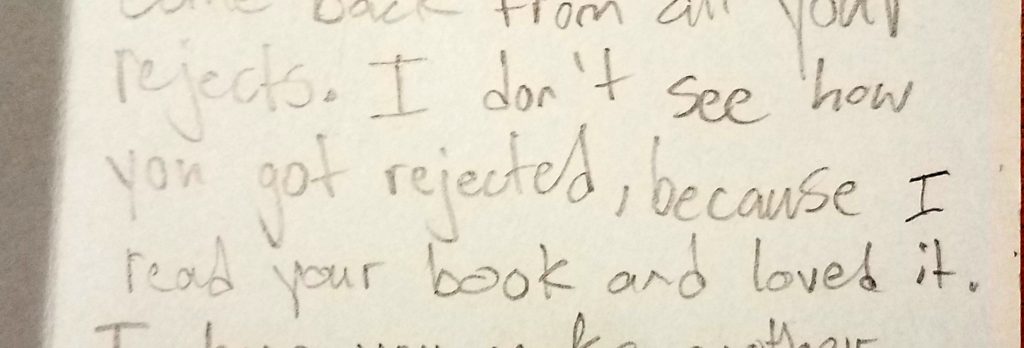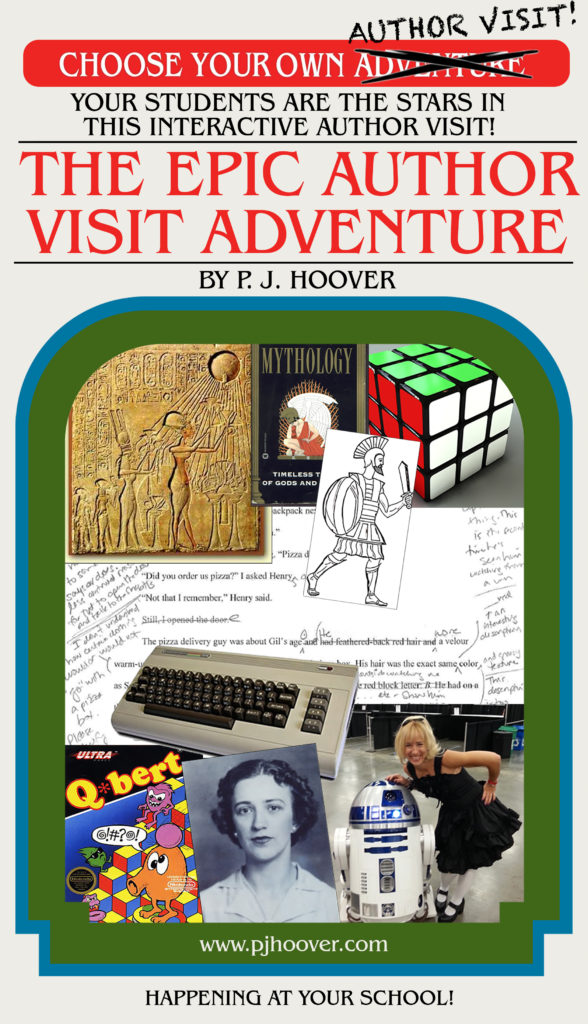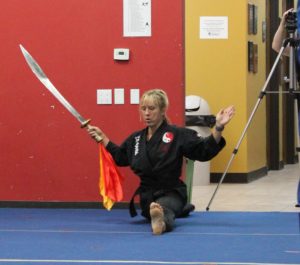When it comes to keeping young students engaged during school visits, author P.J. Hoover (TUT: MY EPIC BATTLE TO SAVE THE WORLD) is an expert. We asked her biggest advice and it was keeping visits interactive. In this guest post, P.J. gives us 5 tips on making school visits more interactive to keep students listening…

I never would have believed it possible, but I can stand up and talk for forty-five minutes straight without running out of things to say. Growing up, I was never a public speaker, yet somehow that is now a big part of my job. It’s also a part of my job that I love. That said, when I visit schools, kids don’t want to just hear me talk. They want to participate. They want to connect. And this participation and connection makes the school visit presentation so much more fun and successful for everyone involved.
Getting kids involved in a presentation is a tricky line to walk. Too much interaction and the presentation can go off the rails. Too little and the kids will be tempted to share private conversations with their friends instead. In my eleven years of doing school visits, I’ve come up with some successful tips to make a school visit more interactive and fun for all.
1. Kids (and adults) of every age love games.
For all age groups of kids, I love to play a simple game. It’s called “How long does it take to get a book published,” and I encourage kids to raise their hands and give me a guess of how long a few of my books took, from first word written until the book was on the bookshelf. Generally the guesses are pretty low. Two months. Four months. A year! Some are very intent on giving precise answers: “I believe it took you two years, four months, and six days.” Kids start to get the hang of it by the third book: four years, five years, seven and a half years. They see the pattern. Books can take a long time to get published. Then I throw them a curve ball and put up a sequel. The guesses are high. The correct answer is one year. Kids are amazed and yet they get it. They understand. It makes them feel smart. And everyone loves to feel smart.
I also admit to the fact that I’ve received rejections in my writing. Many, many rejections. I put out the question: How many rejections have I received so far? The range of answers I get is epic. Elementary school kids guess low, thinking three rejections is just about right. Middle school kids enjoy thinking their guess is way too high (“Over a hundred!”). When they find out the truth (over 350), they are outraged on my behalf. And then we move on.

2. Give them choices
I’ve recently added a new twist to my author visit presentation. It’s called the Choose Your Own Author Visit. In the visit, at certain points in the presentation, the kids get to decide what we talk about. Do we talk about Dwayne (The Rock) Johnson, Thor, or Star Trek? Do we talk about Star Wars, It, or Scooby Doo? How about “The Worst Job Ever” or “My Zany Aunt Katie?” Using an interactive PowerPoint presentation, an awesome clicker with mouse control, and a show of hands, the kids have the opportunity to choose where the presentation goes next. It’s fun for them. It’s way more fun for me since I don’t have to talk about the exact same thing every single time. And it keeps everything much livelier. Win all around.

3. Promise something at the end
In my presentations, when I’m talking about facing your fears, I mention the fact that I know kung fu. I recently tested for my fourth degree black belt, but I tell them the story of the day I decided how I was going to join. I was nervous and almost didn’t walk into the kung fu school. But I pushed through and I accomplished my goal. I quickly realized that the kids ALWAYS wanted to see kung fu moves. At first I tried to do “live” kung fu, but I never found anything that worked well. So instead, I went with a video. After mentioning that I know kung fu, for the younger kids, I show the video right away. For the older kids, I promise that if we have time at the end of the presentation we can watch it. Now the kids have something to look forward to at the end of the presentation. They never forget to ask.
I also know how to solve a Rubik’s Cube. In every crowd there is always at least one kid who knows how to solve it also. Given time, I am ALWAYS up for a Rubik’s Cube challenge. I’ll bring two cubes, get a volunteer from the audience, and we’ll have a contest to see who can solve it faster. (The kid always wins.) Kids love cheering for their classmate. I love embracing this nerdy and fun skill. And everyone walks away happy.
4. Change the presentation based on age group
When I do present to kids in second grade and below, I realized early on that I had to make my presentations much more interactive in order to keep their focus. Enter the game “Fact or Fiction.” Through a fun quiz where the kids have to answer whether they think what I’m saying is a fact or is fiction, we can cover quite a bit of ground.
Fact or Fiction: I always wanted to be an author. FICTION.
Fact or Fiction: Video games are bad for you. FACT and FICTION.
Fact or Fiction: I am a ninja. FICTION, but . . . it’s a nice lead-in to facing fears and my kung fu background.
I’ve found it’s important to mix in silly questions along with those that are more focused in order to keep their eyes and attention on me. Also who doesn’t want permission to play video games?

5. Consider your size and location
There are a couple of quick tips I’ve noticed to help make any author visit more interactive and successful.
Group size: It’s not always possible to have smaller groups, but as the kids get bigger, smaller groups can really help kids get more out of the author presentation. Sure, a packed cafeteria with five hundred kids can be great for getting every kid in the school to see the author, but it also makes any sort of interaction nearly impossible. If you can split your groups up, it’s a great way to go.
Location: Not too long ago, I presented to a couple of smaller groups in a classroom setting. It was middle school, and I was shocked (and a little sad) at how little the kids answered my game questions or asked questions of their own at the end. When I told my own kids about this, they told me that it is “totally not cool” to raise your hand and ask questions in a classroom setting. Had I known this ahead of time, I might have suggested having the presentation in the library instead. Kids loosen up when they are out of their normal setting. Look for ways to make this possible. If you are in a classroom, have them sit on the floor. Have them move chairs around. An author visit is very different than a regular classroom lecture, but in order for kids to realize this, it has to feel different.
Good luck with your next author visit! May you and the kids have an amazing time!
Read more about P.J. Hoover and her books on her speaker page.
